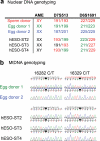Towards germline gene therapy of inherited mitochondrial diseases
- PMID: 23103867
- PMCID: PMC3561483
- DOI: 10.1038/nature11647
Towards germline gene therapy of inherited mitochondrial diseases
Abstract
Mutations in mitochondrial DNA (mtDNA) are associated with severe human diseases and are maternally inherited through the egg's cytoplasm. Here we investigated the feasibility of mtDNA replacement in human oocytes by spindle transfer (ST; also called spindle-chromosomal complex transfer). Of 106 human oocytes donated for research, 65 were subjected to reciprocal ST and 33 served as controls. Fertilization rate in ST oocytes (73%) was similar to controls (75%); however, a significant portion of ST zygotes (52%) showed abnormal fertilization as determined by an irregular number of pronuclei. Among normally fertilized ST zygotes, blastocyst development (62%) and embryonic stem cell isolation (38%) rates were comparable to controls. All embryonic stem cell lines derived from ST zygotes had normal euploid karyotypes and contained exclusively donor mtDNA. The mtDNA can be efficiently replaced in human oocytes. Although some ST oocytes displayed abnormal fertilization, remaining embryos were capable of developing to blastocysts and producing embryonic stem cells similar to controls.
Figures



Comment in
-
Chromosome biology: mixing it up.Nat Rev Mol Cell Biol. 2012 Dec;13(12):750. doi: 10.1038/nrm3476. Epub 2012 Nov 15. Nat Rev Mol Cell Biol. 2012. PMID: 23151661 No abstract available.
References
-
- Gropman AL. Diagnosis and treatment of childhood mitochondrial diseases. Current neurology and neuroscience reports. 2001;1:185–194. - PubMed
-
- Haas RH, et al. Mitochondrial disease: a practical approach for primary care physicians. Pediatrics. 2007;120:1326–1333. doi:10.1542/peds.2007-0391. - PubMed
-
- Schaefer AM, et al. Prevalence of mitochondrial DNA disease in adults. Annals of neurology. 2008;63:35–39. doi:10.1002/ana.21217. - PubMed
Publication types
MeSH terms
Substances
Grants and funding
LinkOut - more resources
Full Text Sources
Other Literature Sources
Medical
Research Materials

